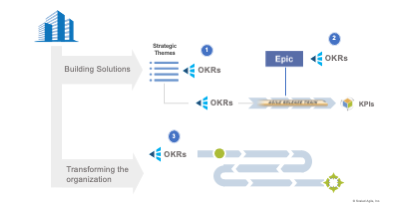
Applying OKRs in SAFe – New Advanced Topic Article
Over the last few years, many enterprises have embraced establishing Objectives and Key Results (OKRs) to create aspirational goals that drive higher organizational performance. SAFe has always recognized the benefits of an objective-driven approach and achieves this starting with Strategic Themes —structured in OKR format — as a means to create strategic alignment and guide PI Objectives.
But OKRs are a pretty comprehensive tool, and the question of how and where to further apply OKRs within SAFe comes up fairly frequently. To this end, we are excited to announce a new Advanced Topic Article that describes three additional and specific use cases for Applying OKRs in SAFe.
- Enhancing strategic alignment across a SAFe Portfolio by creating Value Stream and ART OKRs
- Using OKRs to define business outcomes for Epics, Lean Business Cases, and MVPs
- Defining OKRs to set improvement goals for the SAFe transformation
The article also contains practical guidance on writing well-formed outcome-based objectives, with measurable key results that apply to each scenario. The use of OKRs to help establish solution Key Performance Indictors (KPIs) is also described.
While this article describes opportunities to apply OKRs within SAFe, their usage remains optional, apart from the strong recommendation to use them to describe portfolio Strategic Themes. If a decision is taken to apply OKRs, these must be applied within an environment conducive to their success. The article concludes with a special caveat where OKRs do not work in SAFe as well as one might anticipate.
The benefits of OKRs will only be realized where planning and delivery are incremental, ensuring the ability to respond to the continuous feedback that OKRs provide. Enterprises that still employ traditional development methods, with an upfront commitment to large batches of work, will often struggle to reap the benefits of OKRs.
We look forward to hearing your feedback and how you have used OKRs successfully within your SAFe Enterprise.
Stay SAFe
— Andrew






Florian Beck
Thank you for the new and updated OKR article. It matches our internal discussions about OKR and SAFe, and the examples are beneficial.
Till now, I was not a fan of using OKRs within epics. But, the example Epic Hypothesis Statement and the use of the OKR formula to clarify the expected Business Outcomes are convincing. So I need to rethink my opinion about the OKR formula within Epics – Thank you.
harry
Thank you for the comments Florian. We are glad you found the OKR article helpful.
Clint Roszelle
The new article is excellent and much needed! Two suggestions: 1) Keep an eye on the opportunity to leverage Product OKRs as a means for enabling the project to product movement. ART OKRs could serve as that instrument. 2) The OKR to Epic guidance is solid and much needed. I would suggest going a step further and developing a method for comparing key results to investment options as a way of evaluating the most impactful investments. I use the term “investment” as this method can scale for use at the Epic/Initiative level to the Feature level. This is a lightweight method for cutting through to the opportunities forecast to have the greatest impact on the KR needles. This method doesn’t replace WSJF, in fact it can compliment WSJF as the Key Result evaluated is likely going to be the actual measure that represents one of the WSJF components. Most will be BV based (e.g., reduce cost, increase revenue), some will be RR based (e.g., eliminate all threats rated high or above), some will have a TC element (e.g., increase adoption by 2Q22), and finally, some will be OE focused (e.g., 80% of developers obtain Go programming skills). This KR driven weighting can then spur deeper assessment of other WSJF dimensions if/when needed to drive prioritization and sequencing decisions.
harry
Thanks for the comments and suggestions, Clint. We are seeing more organizations adopt OKRs and starting to integrate them into their SAFe practices as you describe above. We’ll take a look at your suggestions for tighter integration.
Namrata Chopra Datta
Thanks for these insights Andrew, great to see such articles are more info coming from SAFe. only one challenge we are facing – PI Objectives well defined, developed in PI by the ART but the Key results that can be expected from these will be able to capture once things move to production and product telemetry helps us to gain those over all at Solution Level. So realise those benefits its taking little longer. Check-ins are able to give activities but not right outcomes. For Product teams its helpful and fast but for large solutions there is a delay. Any suggestions or approach you have tried
Will share more learnings as we progress further.
harry
Thanks for the response Namrata. It is certainly the case that many features can’t be fully measured until after release. We strive for PI Objectives that can be measured by the end of the PI, even though their full business value can’t be evaluated until afterward.